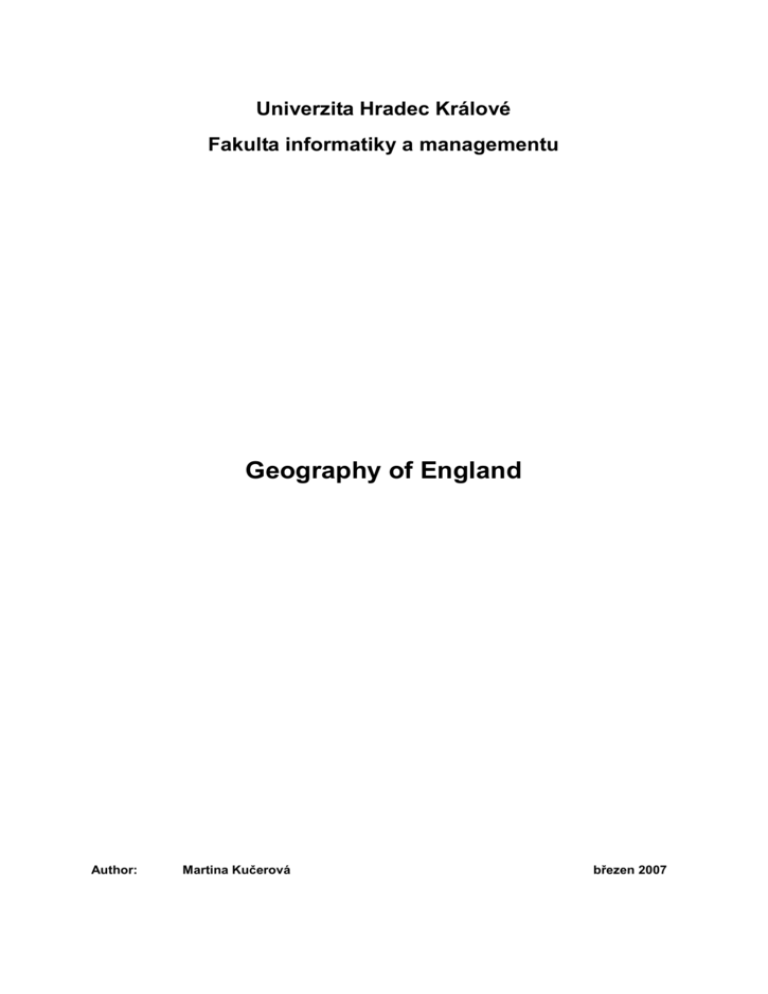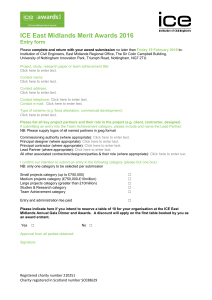Geography of England - Lide na UHK
advertisement

Univerzita Hradec Králové Fakulta informatiky a managementu Geography of England Author: Martina Kučerová březen 2007 Obsah SURFACE .............................................................................................................................................................. 3 HIGHLANDS......................................................................................................................................................... 3 LOWLANDS ......................................................................................................................................................... 3 SOUTHWEST PENINSULA ..................................................................................................................................... 3 WATERS .............................................................................................................................................................. 4 CLIMATE ............................................................................................................................................................. 4 DEMOGRAPHICS ............................................................................................................................................... 4 INDUSTRY ............................................................................................................................................................ 5 GEOGRAPHICAL DIVISION ............................................................................................................................ 5 THE SOUTH OF ENGLAND .................................................................................................................................... 5 THE ENGLISH MIDLANDS .................................................................................................................................... 5 THE NORTH OF ENGLAND ................................................................................................................................... 5 INSERTION NO. 1 ............................................................................................................................................... 7 INSERTION NO. 2 ............................................................................................................................................... 8 2 Surface England is one of four countries of United Kingdom of Great Britain and Northern Ireland. It’s surrounded by the Irish Sea, North Sea and Atlantic Ocean. Atlantic is in the south connected with the North Sea by English Channel, also known as La Manche. England comprises two-thirds of island of Great Britain and is bordered to the north by Scotland, to the west by Wales and from France is divided only by 34 km sea gap. To England belong several islands: Isle of Wight (southern coast of England), Isles of Scilly (about 140 small islands in the Atlantic ocean off the extreme south-western tip of England) and Channel Islands (near to the French coast). Highlands The oldest range of mountains in England originate from the end of the Paleozoic Era, approximately 300 million years ago. It’s called the Pennines, backbone of England. Their total lenght is about 400 km and their highest peak is the Cross Fell (893) in eastern Cumbria in the North West. The Pennines have asymmetric slopes, western are steeper, eastern more moderate, and they are made up of sandstone and limestone. In the calcit areas came the karst areas into being, especially in the Yorkshire and Derbyshire county. The landscape of the Pennines is in general constituted by upland areas of high moorland indented by the more fertile valleys of the region's various rivers. We can find three national parks in the Pennines: Yorkshire Dales National Park (most of it is in North Yorkshire, small part in Cumbria), Northumberland National Park (covering about a quarter of Northumberland county) and the Peak District National Park (mainly in northern Derbyshire). In the Pennines are also the finding places of black coal. The highest point in England, Scafell Pike (978), lies in the Cumbrian mountains, which are more known as the Lake District after many lakes there. It’s one of England’s most popular recreation areas. Lake Windermere is the lagest lake in England. The Cheviot hills are a range of rolling hills straddling the England / Scotland border and their English section belongs to the Northumberland National Park. The Cheviot is the highest hill with 815 metres. Lowlands The English Lowlands cover all England south of the Pennines and east of Wales and the Southwest Peninsula. The Lowlands consist chiefly of broad, gently rolling plains, broken here and there by low hills and ridges. A grassy plain called the Midlands lies in the centre of the English Lowlands, just south of the Pennines. Parts of the Midlands extend along the western and eastern borders of the Pennines.1 The Cotswold Hills are the limestone tableland between Bristol and Cheltenham in the West Country region. Chiltern Hills are the chalk tableland between Oxford and London. The North Downs and the South Downs, made up of chalk and sandstone, lies South of the Thames. Where the hills reach the sea, they form great white cliffs. The chalk cliffs which can be seen both at Dover and on the coast of France are the proof that British Isles were a long time ago connected with the Europen Continent. Southwest Peninsula On the Southwest Peninsula lies only one region - West Country. It lies across the Bristol Channel to the south Wales. It is a granitic plateau with wolds and uplands, the moorland plateaus of Dartmoor and Exmoor, and many picturesque valleys. Its sheltered areas are noted 1 Modified after <http://www.fao.org/forestry/site/18310/en/gbr/page.jsp> (accessed 11.3.2007) 3 for their mild climate. Dartmoor, upland and National Park, is known for granite hilltops. Exmoor’s landscape is covered by grass-grown and heathery moorland (it is also National Park). Waters To the most important rivers in England belong the tidal rivers Thames, Mersey and Tyne with their ports London, Liverpool and Newcastle. The tides of the North Sea and Atlantic Ocean raise level of water in the estuaries and enable even ocean-going ships to enter ports at some distances from the coast. Thames is the second longest river in England (346 km). It springs near Kemble in the West Country and it empties into the North Sea. It runs through Oxford. Mersey is 112 km long and is formed from three tributaries in Greater Manchester. It’s mouth is in Liverpool Bay. Tyne is only 100 km long and it is formed by the confluence of two rivers, the North Tyne and the South Tyne. The longest river in England is Severn with its 354 km. Severn springs in Plynlimon, Wales and empties into Bristol Channel. It is famous for the tidal waves called the Severn Bore. The waves can reach two metres in height. Lakes are situated mostly in Lake District area. As already mentioned, Lake Windermere is the largest lake in England. Lake Derwentwater is called „Queen of lakes“ because of its beauty. Climate The weather is highly changeable on a day-to-day basis but has a quite small differences between average conditions on a seasonal level. England has temperate climate with plentiful rainfall around the year, with temperatures rarely below -5°C or above 30°C. Northern and western parts are usually wetter and colder than the rest of England. The sunniest and warmest areas are in the south and south east. Winter and autumn are usually the wettest seasons. It can be quite windy, especially in the north and west. In general, winters are milder than in Central Europe because of the Gulf Stream. Summers are warm in the south, usually with temperatures between 20 – 25°C (mild climate) but it is not unusual that it is also rainy. If there was not the Gulf Stream, England would be much colder because its northern parts are at the same latitudes as Alaska. Demographics England is both the most populous and the most ethnically2 and religiously3 diverse nation in the UK due to immigration in the past decades. Inhabitants of England account for more than 85 % of the total population of the UK, about 50 million, and its area is about 130 395 square metres. It is also one of the most densely populated countries in Europe with 383 people per square kilometre. It is also true that England has the similar problem with population as the whole Europe has – the population is ageing. This can lead to many economical problems in the future. 2 3 See Insertion No. 1 See Insertion No. 2 4 Industry England was the birthplace of the Industrial Revolution in 18th century and was the first country in the world to become industrialised. England’s economy is the largest economy of the four economies of the UK – its GDP in 2006 was 35 300 $ / per capita. Traditional heavy and manufacturing industries have declined in recent decades, on the other hand service industries have grown in importance. Today, England belongs to leaders in the chemical and pharmaceutical sectors and in key technical industries such as aerospace, arms industry or software industry. London itself is the international financial centre (the largest in Europe) and there is also the largest Europian stock exchange. England imports foodstuffs such as tea, raw sugar, butter and meat, materials like timbers, metals and wool, and petroleum. Whereas it exports mainly manufactured goods and beef meat. Geographical Division England comprises 46 countries which can be divided most generally into three sections. These can be further divided into regions, which consist of counties. The South of England We can say that it is the area south of the River Thames and the Bristol Channel. o London capital city of both England and the UK o South East area around and south of London Counties: Kent, East Sussex, West Sussex, Surrey, Oxfordshire, Berkshire, Buckinghamshire, Hampshire, Isle of Wight o The West Country Counties: the Souhwest Peninsula Dorset, Somerset, Gloucestershire, Devon, Wiltshire, Cornwall The English Midlands The area east of Wales and across the North Sea. o East Anglia low-lying territory northeast of London Counties: Bedfordshire, Essex, Norfolk, Hertfordshire o The East Midlands Counties: Suffolk, Cambridgeshire, the geographical centre of England Derbyshire, Leicestershire, Lincolnshire, Northhamptonshire, Nottinghamshire, Rutland o The West Midlands industrial and rural area east of theWales Counties: Staffordshire, Shropshire, Herefordshire, Warwickshire, The West Midlands County Worcestershire, The North of England The area north of the River Mersey. o Yorkshire regarded as one of the most scenic, varied and interesting of all the regions Counties: North Yorkshire, West Yorkshire, South Yorkshire, East Yorkshire 5 o The North West Counties: contrast of industrial cities and breathtaking scenery Cumbria, Lancashire, Cheshire, Merseyside, Greater Manchester o The North East Counties: the area on borders with Scotland Northumberland, Durham, Cleveland, Tyne, Wear 6 Insertion No. 1 Ethnicity in England 90,00% 80,00% 70,00% 60,00% 50,00% 40,00% 30,00% 20,00% 10,00% 0,00% 1 1 White British 86,99% White Other 2,66% Indian 2,09% Pakistani 1,44% Mixed 1,31% White Irish 1,27% Black Caribbean 1,14% Black African 0,97% Bangladeshi 0,56% Other Asian 0,48% Chinese 0,45% Other 0,44% Black Other 0,20% 7 Insertion No. 2 Religion in England 70,00% 60,00% 50,00% 40,00% 30,00% 20,00% 10,00% 0,00% 1 Church of England 63,30% No Religion 14,81% Roman Catholics 7,75% Not Stated 7,71% Muslim 2,97% Hindu 1,06% Jedi 0,70% Sikh 0,63% Jew ish 0,50% Other 0,29% Buddhist 0,28% 8





